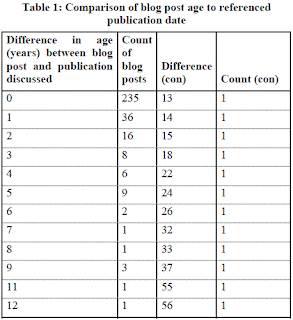I love the Groth and Gurney (2010) research, and not just because it introduced me to http://researchblogging.org/. The authors analyzed 295 blog posts about chemistry and the included citations. In comparison to the usual pieces which deal with science blogging in the scholarly literature, this paper has dealt with a large number of posts.
Most of what I've read about science blogging are either opinion articles (Batts et al, 2008), or qualitative research, aka interviews with a small number of bloggers the authors deem important (Amsen, 2006; Kjellberg, 2010). Mind you, there's nothing wrong with those - in fact, they make a fascinating reading - but every now and then a girl needs some good, solid numbers to put in her literature review. Yes, I'm aware of the Kouper paper, but its methodological flaws have already been discussed extensively.
But back to the Groth and Gurney paper. They have found, as expected, that most papers were published in the same year as the blog posts discussing them (table taken from the paper), which, of course, shows one of the main advantages of blogs over traditional scientific literature: They're as current as your last breath.

They have also found that "scientific discourse on the Web focuses on high quality science", based on their finding that 70.5% of the citations came from high-impact journals.
Strictly speaking, it's wrong to judge a paper by its journal, but I didn't expect them to evaluate 300 papers on their own. Terribly time-consuming. So, the IFs of the journals are used as approximations.
There's more, of course, but I won't deal with the rest in this post. I hope that Groth and Gurney will expand their research to other disciplines in the future.
Groth, P. & Gurney, T. (2010). Studying Scientific Discourse on the Web Using
Bibliometrics: A Chemistry Blogging Case Study In press
Kjellberg, S. (2010). I am a blogging researcher: Motivations for blogging in a scholarly context First Monday, 15 (8)
Amsen, A. (2006). Who benefits from science blogging? Hypothesis (4)
Kouper, I. (2010). Science blogs and public engagement with science: practices, challenges, and opportunities. Journal of Science Communication, 9 (1)
Batts, S. A., Anthis, N. J. & Smith, T. C. (2008). Advancing Science through Conversations: Bridging the Gap between Blogs and the Academy. PLoS Biology, 6 (9) DOI: 10.1371/journal.pbio.0060240
if you want something different from quantitative or qualitative, you could look at my SNA paper :)
ReplyDeleteDetecting Communities in Science Blogs, presented at the 4th IEEE International Conference on eScience, in Indianapolis, December 10, 2008. It's archived here: http://terpconnect.umd.edu/~cpikas/ScienceBlogging/PikasEScience08.pdf
(ps - happy to meet you, glad Bora linked to your blog... we need more LIS PhD students in the blogosphere!)
Hi there, happy to meet you as well:) Actually, I printed out your paper a few days ago, but haven't had the time to read it yet.
ReplyDeleteDespite my rants, it's actually a good thing there aren't many papers out there about science blogging: more for us to research.